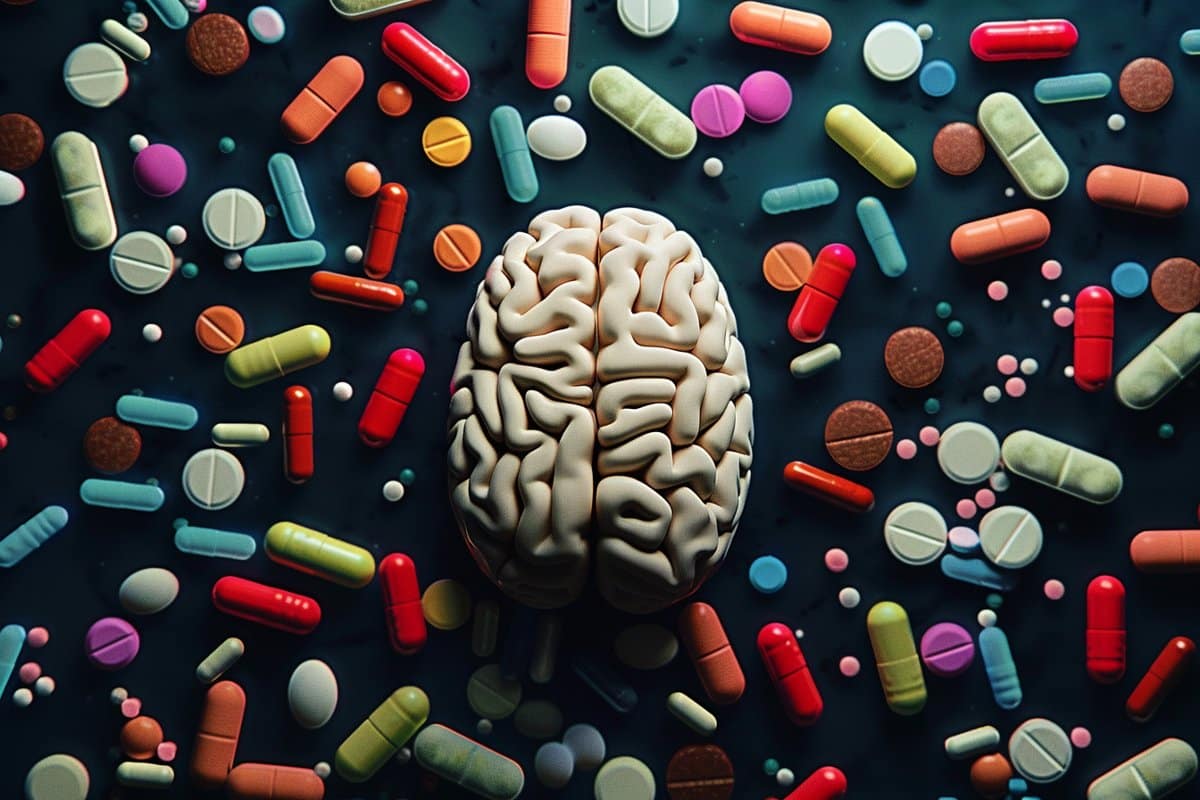Summary: Researchers made significant advances in understanding how drugs like cocaine and morphine disrupt the brain’s natural reward mechanisms. Their study reveals that these drugs manipulate the same brain cells responsible for processing natural rewards, leading to compulsive drug-seeking behaviors.
By employing advanced neuroscientific techniques in mouse models, the team tracked how neurons in the nucleus accumbens respond to both natural rewards and drugs. This research not only deepens our understanding of addiction but also identifies potential targets for innovative treatments.
Key Facts:
- The study identifies specific neurons in the nucleus accumbens that are affected by both natural rewards and drugs, explaining the mechanism behind the powerful grip of addiction.
- Advanced tools allowed researchers to observe how repeated drug exposure alters neuronal responses, increasing the preference for drugs over natural rewards.
- The findings point to the mTORC1 signaling pathway and the Rheb gene as potential therapeutic targets, offering hope for new addiction treatments.
Source: Mount Sinai Hospital
Mount Sinai researchers, in collaboration with scientists at The Rockefeller University, have uncovered a mechanism in the brain that allows cocaine and morphine to take over natural reward processing systems.
Published online in Science on April 18, these findings shed new light on the neural underpinnings of drug addiction and could offer new mechanistic insights to inform basic research, clinical practice, and potential therapeutic solutions.

“While this field has been explored for decades, our study is the first to demonstrate that psychostimulants and opioidsengage and alter functioning of the same brain cells that are responsible for processing natural rewards,” explains senior author Eric J. Nestler, MD, PhD, Nash Family Professor of Neuroscience, Director of The Friedman Brain Institute, and Dean for Academic Affairs of the Icahn School of Medicine at Mount Sinai, and Chief Scientific Officer of the Mount Sinai Health System.
“These findings provide an explanation for how these drugs can interfere with normal brain function and how that interference becomes magnified with increasing drug exposure to ultimately redirect behavior compulsively towards drugs —a hallmark of addiction pathology.”
The study focused on identifying convergent mechanisms of addiction in mouse models across two different classes of drugs: cocaine, a psychostimulant, and morphine, an opioid.
This groundbreaking work required the amalgamation of a highly interdisciplinary team, organized by Dr. Nestler and long-time collaborator Jeffrey M. Friedman, MD, PhD, Marilyn M. Simpson Professor at The Rockefeller University, Investigator of the Howard Hughes Medical Institute, and co-senior author of the study.
Among its members were two biophysicists: Alipasha Vaziri, PhD, Professor of Neuroscience and Behavior at The Rockefeller University and a co-senior author of the study, and Tobias Nöbauer, PhD, Assistant Research Professor at The Rockefeller University and a co-first author of the study. Working closely together, the team employed a suite of cutting-edge tools and methodologies spanning behavioral, circuit, cellular, and molecular domains of neuroscience.
Through these innovative efforts, researchers were able to track how individual neurons in a forebrain region called the nucleus accumbens respond to natural rewards like food and water, as well as to acute and repeated exposure to cocaine and morphine in a cell-type-specific manner.
They discovered a largely overlapping population of cells that respond to both addictive drugs and natural rewards, and demonstrated that repeated exposure to the drugs progressively disrupts the cells’ ability to function normally, resulting in behavior being directed toward drug-seeking and away from natural rewards.
“By tracking these cells, we show that not only are similar cells activated across reward classes, but also that cocaine and morphine elicit initially stronger responses than food or water, and this actually magnifies with increasing exposure,” notes co-first author Caleb Browne, PhD, a former Instructor in Dr. Nestler’s lab who is now a Scientist in the Campbell Family Mental Health Research Institute at the Centre for Addiction and Mental Health (CAMH) in Toronto.
“After withdrawal from the drugs, these same cells exhibit disorganized responses to natural rewards in a manner that may resemble some of the negative affective states seen in withdrawal in substance use disorder.”
Moreover, the research team identified a well-established intracellular signaling pathway—mTORC1—that facilitates the disruption of natural reward processing by the drugs.
As part of that discovery, investigators found a gene (Rheb) that encodes an activator of the mTORC1 pathway that may mediate this relationship, potentially providing a novel therapeutic target for future discovery in a field of medicine that currently offers few effective treatments.
To that end, the research team plans to dig deeper into the cellular biology behind addiction neuroscience to better characterize molecular pathways that could be critical to basic research and, eventually, clinical practice.
“Through our work we have also established a landmark dataset that integrates drug-induced brain-wide neural activation with input circuit mapping from the nucleus accumbens, which could be useful to the broad scientific community conducting substance use disorder research,” says Bowen Tan, the other co-first author of the study, and a graduate student in the laboratory of Dr. Friedman.
“We’ve known for decades that natural rewards, like food, and addictive drugs can activate the same brain region,” says Dr. Friedman.
“But what we’ve just learned is that they impact neural activity in strikingly different ways.
“One of the big takeways here is that addictive drugs have pathologic effects on these neural pathways, that are distinct from, say, the physiologic response to eating a meal when you are hungry or drinking a glass of water when you are thirsty.”
“A major part of our ongoing research will be directed to defining how the flow of multimodal information is incorporated into value computations in brain cells and how that crucial mechanism enables drugs to overtake the processing of natural rewards, leading to addiction,” says Dr. Nestler.
Funding: Research reported in this press release was supported by the National Institute on Drug Abuse and the National Institute of Neuronal Disorders and Stroke, both part of the National Institutes of Health under award numbers P01DA047233, R01DA014133, 5U01NS115530, 1RF1NS110501, and 1RF1NS113251. The content is solely the responsibility of the authors and does not necessarily represent the official views of the National Institutes of Health.
About this addiction and neuroscience research news
Author: Elizabeth Dowling
Source: Mount Sinai Hospital
Contact: Elizabeth Dowling – Mount Sinai Hospital
Image: The image is credited to Neuroscience News
Original Research: Closed access.
“Drugs of abuse hijack a mesolimbic pathway that processes homeostatic need” by Eric J. Nestler et al. Science
Abstract
Drugs of abuse hijack a mesolimbic pathway that processes homeostatic need
INTRODUCTION
Drugs of abuse produce pleasurable feelings and reinforce consummatory behavior directed toward their acquisition. These same properties are characteristic of natural rewards that satisfy innate needs, such as food or water. Decades of research has shown that brain systems processing natural rewards are also impacted by drugs of abuse at the physiological, circuit, cellular, and molecular levels.
These findings raise the hypothesis that drugs of abuse cause addiction by “hijacking” a common reward pathway, ultimately promoting drug intake while curbing other healthy goals. However, the specific neural substrates for such a shared reward pathway remain unidentified.
RATIONALR
Identification of a neural substrate that processes multiple classes of rewards necessitates multimodal analysis of neurobiological functions. This includes pinpointing central nodes that respond to reward exposure, examining specific cell types within this brain node that encode distinct rewarding experiences within the same individual, and identifying molecular effectors that mediate cellular and physiological adaptations.
For this purpose, we employ a combination of approaches including whole-brain neuronal activity mapping, in vivo two-photon longitudinal calcium imaging at single-neuron resolution, and single-cell sequencing after in vivo CRISPR perturbation of a candidate gene. These multifaceted approaches enable the exploration of multiple components that comprise a common reward pathway and allow us to study how repeated drug exposure “hijacks” innate needs through this shared conduit.
RESULTS
Using whole-brain FOS mapping combined with chemogenetic inhibition approaches, we identify the nucleus accumbens (NAc) as a central hub necessary for both cocaine and morphine to disrupt natural reward (food and water) consumption. In vivo longitudinal tracking of individual dopaminoceptive neuron activity in the NAc in awake, behaving mice revealed overlapping ensemble responses across drugs of abuse and natural rewards, with drugs producing greater levels of activation.
Repeated exposure to drugs of abuse augmented cell type–specific neural dynamics indicative of an escalation of drug responses, and subsequently disorganized natural reward processing in the NAc after drug withdrawal. We then developed a “FOS-Seq” approach to correlate brain-wide FOS patterns with brain-wide in situ gene expression data. We identified Rheb, a gene encoding a small GTPase that activates the mTOR pathway, as being correlated with FOS induction by chronic exposure to either cocaine or morphine.
By integrating in vivo CRISPR perturbation of Rheb with single-nucleus RNA sequencing in the NAc, we demonstrated an essential role of Rheb in regulating signal transduction pathways associated with drug action in dopaminoceptive cells, and in diminishing natural reward consumption after chronic exposure to drugs of abuse.
Finally, functional mapping of NAc-projecting neurons from regions that are activated by drugs of abuse points to orbitofrontal cortex as a potential ascending node that curbs natural reward consumption as verified with chemogenetic activation.
CONCLUSION
We delineated a common reward pathway that enables drugs of abuse to interfere with the fulfillment of homeostatic needs for food or water. These findings provide mechanistic insights into the intensification of drug-directed behavior in substance use disorders.






